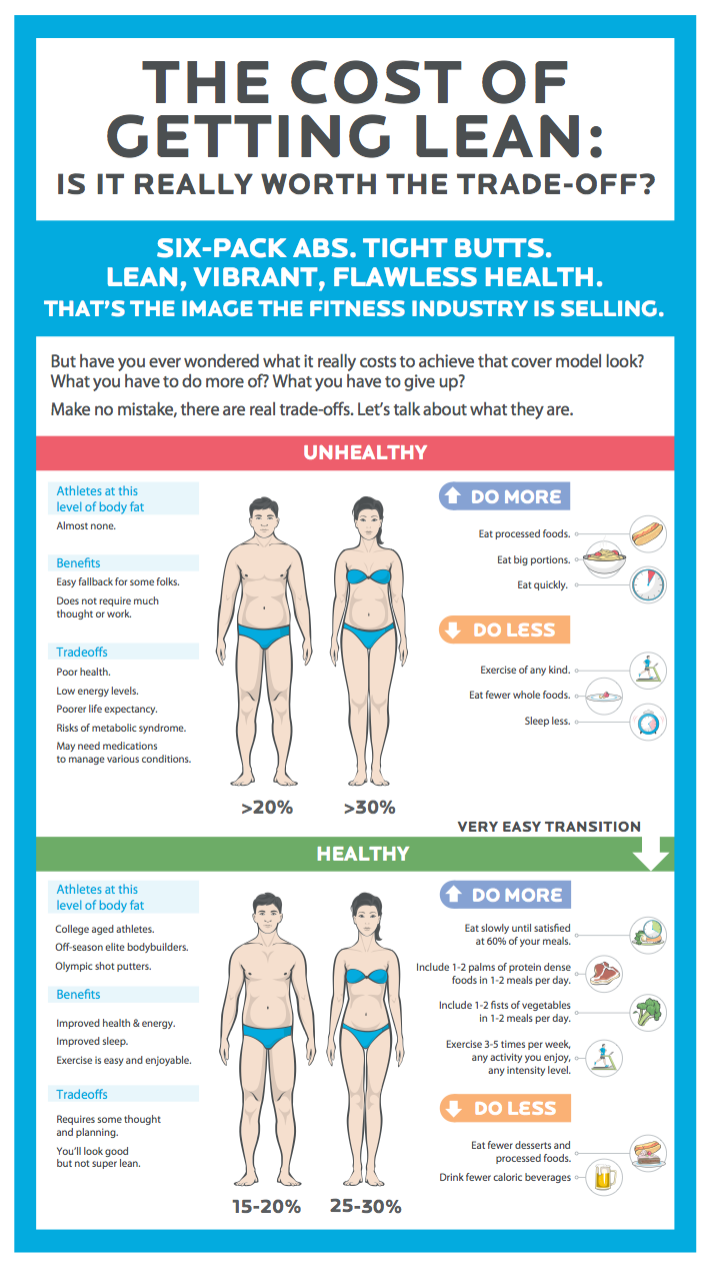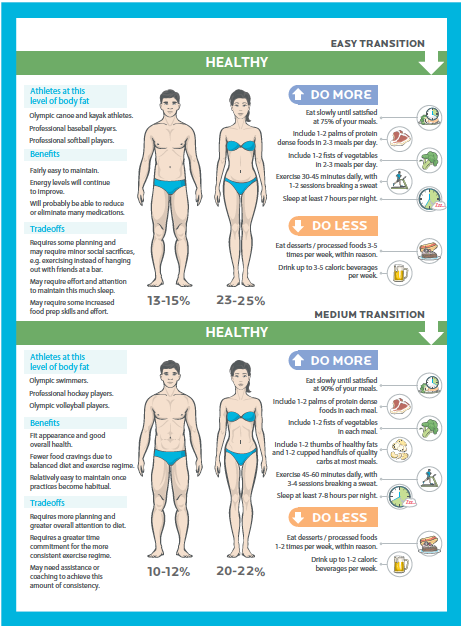
Before we start, let’s take a few things into consideration and define some terms.
What does it take to put on muscle? What does it take to burn fat? What kind of sacrifice are you comfortable with? Where is your end goal?
Calories = The energy needed to raise the temperature of 1 gram of water through 1 °C.
Daily Intake = The amount of calories you consume in a day.
RMR = Resting Metabolic Rate. This is the amount of calories your body burns at rest.
Let’s start off by looking at the numbers that are usually used when calculating weight change.
So what does it take to add and maintain just 1lb of muscle to your body? Let’s look at some numbers: It’s typically recommended to add 500 calories to your daily intake for muscle building. 1kg of muscle burns ~6 cal/day at rest. Extra muscle mass will also add to your caloric burn while moving, but this is a number specific to you and your body that I can’t tell you.
You know now that adding 1lb of muscle to your body will take an initial 500 calories/day until you get it, plus 6/day to maintain it after. In theory it’s possible to gain 1lb of muscle in a week. However there are a lot of influencing factors from genetics and hormones to what you eat and how well you sleep. So just remember that progress at any rate is progress, and keep working until you get it. The important variable to remember here is that calories come from all sources and muscle synthesis requires protein. So don’t just add whatever 500 calories you can get your hands on. Eat a balanced healthy diet and add calories from all sources, especially proteins. Try to get about 1-1.5 grams of protein per pound of bodyweight. A healthy rate of muscle gain is about 1.5-2lbs per month.
At this point you may be wondering “Why should I gain weight in muscle to lose weight in fat? Why not just lose the fat?” Well, think of it as an investment. You’re adding useful weight that will help you lose the weight you don’t want. Looking at the numbers above we can see that just 1lb of muscle will boost your RMR by 6 calories/day. If you add a few of those, let’s say you add 5lbs of muscle: Now you’ve added 30 calories to your RMR, that’s an EXTRA 30 calories burned every day!
On to burning off fat.
It is commonly held that to lose 1lb of fat you need to burn ~3500 calories. For example maybe you want to lose 1lb of fat in a week. That will require you reduce your daily intake by about 500 calories (look familiar?). Good ways to reduce your calorie count are cutting out calorie dense drinks, reducing junk/fast food in your diet, or just reducing your portion size slightly in each meal. I’m sure you’ve heard of the magic pills or wacky devices that promise to take off 20-30lbs in a month… Sadly, that’s unrealistic and unhealthy, not to mention losing that much in a short time multiplies the probability of relapse. You should aim to lose around 1-2lbs per week with a solid nutrition and exercise program. This rate of fat loss is easy to adjust to and maintain. If you happen to drop more weight, consider it a bonus.
Now, before you go thinking you can just start an exercise program and watch your lean mass go up while you drop fat because these numbers work; remember that it is important to continue a properly balanced diet and make sure you’re getting enough complete proteins from sources like lean meats, poultry, seafood, eggs and dairy. Also be sure to eat a variety of colourful vegetables.
We’ve talked about the numbers, now let’s talk about you.
So you wanna change your body? How far do you want to take this change? What are you prepared to give up?

This image shows the transition from an unhealthy body composition to a healthy one. You might want this, or not, you may want to go farther. That’s entirely your choice. But before you go jumping head first into a body transformation, you should know the things you can expect to give up. It’s not hard to be healthy, but you don’t get to be lazy, and the benefits are absolutely worth it.
Besides, it’s not like you have to give up ALL your beer and burgers. Just cut back a little. Take it one step at a time, plan it out over a week. If you’re having beer and hot dogs 5 days a week; take one of those days and get a good slab of lean meat, toss a couple fistfuls of veggies on the side and enjoy it. Then you’re on the road to success.
(P.S. You can find the full version of these infographics at www.precisionnutrition.com which will show you from >20% body fat like you see here, all the way to <6%.)

If just hitting a healthy weight just isn’t enough for you, here’s what it takes to go farther:
Keep in mind that this takes a strong commitment and consistency. But it’s a lot of the same process of eliminating foods and activities that are holding you back, just take it to the next level. Keep reducing your processed food and caloric beverage intake. Get lots of physical activity. Shoot for a bare minimum 30 minutes per day, but try to get up for 5 hours of activity each week.Personally I fluctuate between 11% and 15% body fat. Because I’ve given up a lot of junk food and I rarely drink more than a couple beers in a week. But there are occasions that I say screw it and throw it all out the window for a day or two. Sure, I’ve gotta work for a week or three to get back where I was, but I enjoyed myself and that was more important to me. On the flip side, I’ll go for months on a strict diet and workout program trying to hit a target weight before my rugby season starts. Again because that’s what’s important to me. So when you’re planning how much weight you’re going to lose, or how many pounds of muscle to bulk up, keep in mind that you will hit some bumps in the road. Remember to get back on track as soon as you get home from your favourite cousin’s wedding feast.
To recap what we’ve talked about:
Building muscle requires increasing the amount of food you eat, with a preference to proteins like lean meats, seafood, and eggs. Burning fat requires reducing the amount of food you eat, with a preference to unnecessary calories from things like soft drinks, alcohol, and junk food. The key to your success is going to be consistency. If you start working towards losing weight, don’t stop until you get there. Switching your program or diet every few weeks will only sabotage your progress.
What’s your best bet for increasing your caloric burn? Movement. Not just regimented exercise, but movement in general. Get up and get moving. Take the stairs at the office, hit the gym 3 days a week, get involved in a physical activity you enjoy.
Why am I recommending adding lean muscle mass before losing fat? Think of it as switching from your fuel efficient compact car into a gas guzzling SUV. It’s calories instead of gas, and that weight you want to lose is fuel that’s already in the tank of either car.
Don’t just work the numbers, because the numbers I’ve included here are a recommendation based on averages and may be different than what your body needs. It’s important (and you’ll feel better) to keep up a healthy diet.
Be patient, it could take up to 3 weeks before you see significant results. Keep track of how you feel on a daily basis as well as your measurements. I’d recommend measuring once a week to check short term progress, and log measurements every 6 weeks for long term tracking.
References:
- Wang Z, Ying Z, Bosy-westphal A, et al. Evaluation of specific metabolic rates of major organs and tissues: comparison between men and women. http://www.ncbi.nlm.nih.gov/pmc/articles/PMC3139779/
- Berardi J, St. Pierre B. Precision Nutrition workout-nutrition-infographic. Precision Nutrition workout nutrition explained.
- Driskell, Judy Anne and Ira Wolinsky. “Energy-Yielding Macronutrients And Energy In Sports Nutrition“. N.p., 2016. Web. 7 July 2016.



